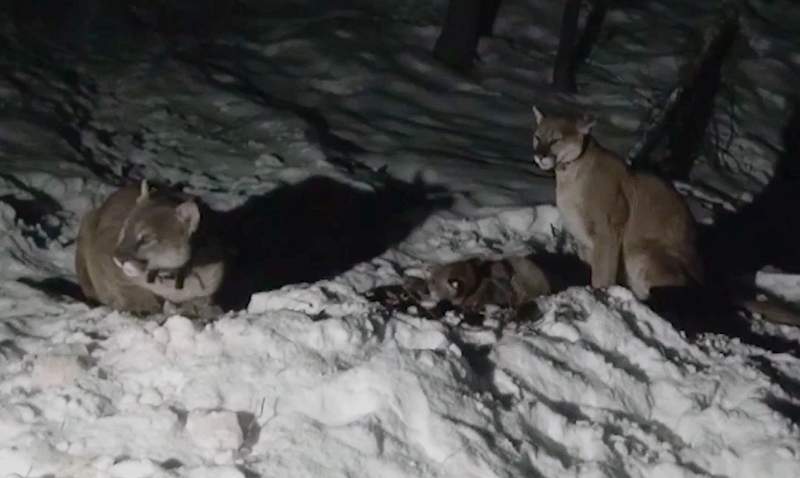A 2002 book on the wild cats tells me that “like most felids, pumas live alone, and apart from associations for mating purposes the only prolonged contact is between females and their kittens” (Wild Cats of the World page 260).
That opening sentence on the social organisation of the puma a.k.a. mountain lion appears, now, after later research to be incorrect. A report on a study published on the National Geographic website found that unrelated female pumas whose home ranges were encompassed by the home range of a common male puma were predisposed to sharing their kills with each other. One female will allow the other to share their kill and the other would then reciprocate likewise.

It showed another side to the hierarchical role of male pumas in pumas society. At the time the discovery was made it was quite revolutionary because up until then the general belief by scientists was that pumas were “solitary, robotic killing machines” according to Mark Elbroch, the lead scientist for the Puma Program at Panthera, the global wild cat conservation organisation.
He said that what the study unveiled “is a secretive animal with a complex social system completely built on reciprocity”. It flew in the face of general opinion about the behaviour of this iconic large wild cat species normally associated with North America, but which also lives throughout the Americas (2022).
A video camera trap showed an adult female puma walking up to the carcass of an animal killed by another unrelated female.
Although they hissed at each other and had a mini face-off (on my interpretation of the report), the female who had killed the animal allowed the other puma to share her meal. It was a generous act of altruism, and the pair of females stayed in each other’s company for 36 hours and more.
It was described at the time as the “first cougar friendship known to science”. Elbroch then discovered that it wasn’t that rare as there were other videos recorded between 2012 and 2015 of 118 interactions between two pumas and 60% of the interactions took place at kill sites with a high percentage of them concerning sharing a meal.
And they found that the incoming puma who was allowed to eat the carcass that they hadn’t killed was 7.7 times more likely on average to return the favour later on.
Elbroch wanted to learn more about this puma society, and he entered into partnership with Mark Lubell and Michael Levy of the University of California, Davis. They mapped the pumas’ relationships to work out how interconnected one individual was within a social group.
The study revealed a cougar society that was hierarchical as described above. The male puma home range includes the home ranges of one or more females. To put that another way as described by Fiona Sunquist in her book Wild Cats of the World, “The home ranges of resident males typically overlap the ranges of one or more females, and the ranges of resident males may overlap one or another extensively, slightly or not at all”.
So two females living within their own home ranges but connected by the fact that one resident male’s home range overlaps both of the smaller female home ranges, may become friends and share their food.
In addition, pumas maintain contact with co-specifics often through a range of indirect communications which includes scrapings on the ground which is a visual form of indirect communication, the sounds that they make and olfactory forms of communication which means scent marking objects in the way that domestic cats scent mark objects. Scent marking is a kind of calling card which tells other pumas that an individual has visited a certain spot at a certain time.
Pumas are not strictly solitary as once believed.
Below are some more articles on this fabulous and iconic wild cat species. Such a beautiful cat but sadly all US states bar California as I understand it allow sport hunting of pumas. It should be entirely banned, and farmers compensated for loss of livestock by puma predation.
Conservation of the puma a.k.a. mountain lion – full discussion 2022

